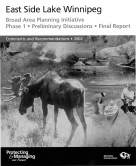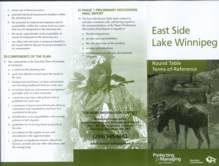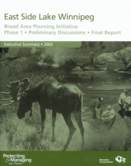
News |
- Amazon Forest, Boreal Forest & West Coast Fisheries
- Bird Populations in Tailspin
- Public Utilities Board Hearings Not Called
- National Parks Funding Topped Up
- New Power Grid Promoted
- Lake Winnipeg At Risk
- New Western Manitoba Harvest Plan
- National Chief Visits Grassy Narrows Blockade
- Free Manitoba Geospatial Data
- Aboriginal Peoples Assert Rights at National Forest Strategy Forum
- Yukon Turns to Manitoba as Environmental Model
- East Side Terms of Reference Released
Amazon Forest, Boreal Forest & West Coast Fisheries |
May 2003 |
 How do decisions made in California affect the environment in Manitoba? How do decisions made in California affect the environment in Manitoba?California's environmental legacy of conserving resources at home is on a collision course with its habit of consuming them in record quantities from abroad. Often the losers are impoverished citizens and communities — and spectacular ecosystems — in remote parts of the globe, where money speaks louder than the land. View the Sacramento Bee article on Canada's Boreal forest regions |
|
Bird Populations in Tailspin |
March 2003 |
 Bird populations around the world are plummeting faster than ever before, and human factors—from population growth to habitat destruction and climate change—are at the center of this demise, according to a new study from the Worldwatch Institute, a Washington, D.C.-based research organization. Human-related factors are threatening 99 percent of the most imperiled bird species and contributing to what has become the greatest wave of extinctions since dinosaurs disappeared 65 million years ago, according to Howard Youth in Winged Messengers: The Decline of Birds, which was released in late March 2003. Bird populations around the world are plummeting faster than ever before, and human factors—from population growth to habitat destruction and climate change—are at the center of this demise, according to a new study from the Worldwatch Institute, a Washington, D.C.-based research organization. Human-related factors are threatening 99 percent of the most imperiled bird species and contributing to what has become the greatest wave of extinctions since dinosaurs disappeared 65 million years ago, according to Howard Youth in Winged Messengers: The Decline of Birds, which was released in late March 2003."Declining bird populations mark not only the loss of unique species," says Youth, "but also the unraveling of delicate natural balances. Birds are valuable environmental indicators because they warn us of impending problems through their waning or flourishing populations." With twelve percent of the world’s bird population—almost 1,200 species—facing extinction in the next century, Winged Messengers outlines an array of phenomena that is accelerating this demise. These include: * Habitat loss: Deforestation rates from 50,000 to 170,000 square kilometers a year pose the single greatest overall threat, jeopardizing 85 percent of the world’s most threatened bird species. While forest re-growth initiatives offset the net losses, for many native animals and plants, simplified plantation monocultures are no substitute for more complex natural forests. * Climate change: Recent evidence of earlier bird migration and nesting in some species seems to indicate early effects of global warming. Scientists fear that in coming years climate change will alter vital bird habitats, from tundra to subtropical coastlines, even pushing some localized species towards extinction. Conservation biology—a new approach to natural habitat protection that blends biology, conservation science, economics, and the mutual engagement of conservationists, communities, and business—has changed the focus of biodiversity protection. This new approach factors in protected areas for conservation, and also adjacent lands, water resources, and the people who inhabit and use them. "Birds provide us with food, inspiration, a link to nature, and an alert system for detecting environmental ills, but today, this feathered resource is in great need of human attention." Order "Worldwatch Paper 165: Winged Messengers: The Decline of Birds" |
|
Public Utilities Board Hearings Not Called |
March 2003 |
 The Manitoba government announced in January 2002 they would authorize a Public Utilities Board (PUB) review process to assess the justification for new hydroelectric projects that may be in service prior to 2015. The Manitoba government announced in January 2002 they would authorize a Public Utilities Board (PUB) review process to assess the justification for new hydroelectric projects that may be in service prior to 2015. Since last year’s announcement, a number of hydro projects that may be in service prior to 2015 have been actively promoted. These include: the Wuskwatim generation project and associated transmission facilities, Conawapa generation, Gull Rapids generation, Bipole III transmission project, and the East-West power grid. A decision whether to build the Wuskwatim projects is expected later this year, but there has been no indication of when the PUB hearings will take place. The reference for these hearings has also not been made available. The Wuskwatim environmental licensing process requires the completion of Environmental Impact Statements (EISs), Clean Environment Commission (CEC) hearings, and the completion of a federal Comprehensive Study under The Canadian Environmental Assessment Act. As of this late date, Manitoba Hydro has not filed the required EISs. Neither government has provided any new details on the timing of these processes. View the Manitoba Government press release |
|
Lake Winnipeg At Risk |
February 2003 |
 At a recent Winnipeg water forum, a number of speakers presented a disturbing picture of the current health of Lake Winnipeg. According to these presenters, the aquatic health of the lake is under increasing pressure due to growing levels of nutrients such as nitrogen and phosphorus. At a recent Winnipeg water forum, a number of speakers presented a disturbing picture of the current health of Lake Winnipeg. According to these presenters, the aquatic health of the lake is under increasing pressure due to growing levels of nutrients such as nitrogen and phosphorus. Major sources of nutrients include agriculture run-off from fertilizer use, manure from intensive livestock operations, discharges from municipal and cottage sewage systems, large-scale food processing plants, and other smaller sources. The problem is seen to be wide-ranging throughout watersheds around Lake Winnipeg, requiring coordinated action with other jurisdictions that include Alberta, Saskatchewan, Ontario, North Dakota, Minnesota, and South Dakota. Lake Winnipeg is the tenth largest freshwater lake in the world. Acknowledging these concerns, the Government of Manitoba announced a six-point Lake Winnipeg Action Plan. Among other items, the action plan includes the formation of a new Lake Winnipeg Stewardship Board. The Fresh Water Forum was held in Winnipeg on February 18, 2003. Speakers included scientists from government, universities, as well as representatives from affected communities and other organizations. Other important topics discussed included issues related to drinking water, watershed stewardship, northern Manitoba perspectives, water allocation and conservation. Manitoba is currently in the middle of a number of important water-related public policy processes:
View all presentations at the Manitoba Clean Environment Commission web site |
|
New Western Manitoba Harvest Plan |
March 2003 |
 Mountain Quota Holders Association (MQHA) has completed an Annual Operating Plan (AOP) and associated Environmental Impact Statement (EIS) for the three-year period 2003/2004 to 2005/2006 for forest management unit (FMU) 12 and FMU 14. The area affected includes the Porcupine Provincial Forest in addition to large tracts of land to the east (up to Lake Winnipegosis) and land to the north of Red Deer Lake and Dawson Bay. Mountain Quota Holders Association (MQHA) has completed an Annual Operating Plan (AOP) and associated Environmental Impact Statement (EIS) for the three-year period 2003/2004 to 2005/2006 for forest management unit (FMU) 12 and FMU 14. The area affected includes the Porcupine Provincial Forest in addition to large tracts of land to the east (up to Lake Winnipegosis) and land to the north of Red Deer Lake and Dawson Bay.Both the AOP and EIS can be viewed at any one of the many public registry locations in Manitoba (File #4613.10). Comments on the MQHA AOP and EIS must be submitted in writing to the Environmental Approvals Branch within Manitoba Conservation by April 25, 2003. Comments can also be emailed to threno@gov.mb.ca. Contact Trent Hreno for further information at (204) 945-7080 or Toll Free at 1-800-282-8069. |
|
Free Manitoba Geospatial Data |
May 2003 |
 In spring 2003 the Province of Manitoba has opened up its GIS digital data warehouse on the Internet. Manitoba is providing most of its geospatial data free of charge for unrestricted use. In spring 2003 the Province of Manitoba has opened up its GIS digital data warehouse on the Internet. Manitoba is providing most of its geospatial data free of charge for unrestricted use.GIS data holdings including: topographic data, base maps, soils maps, land use mapping, cadastral data, forest inventory, digital imagery, geology maps, community base maps, all administrative boundaries, quarter section grids, geographical names, water resource mapping, road maps, and other layers. All data files are supported with two popular download formats along with complete FGDC meta data files. Complex licensing requirements and fees have been eliminated and substituted with a simple online registration process where the customer acknowledges the data disclaimer and user agreement. This data warehouse has been developed under the Manitoba Land Initiative (MLI) which is an interdepartmental committee of data producing government agencies. Visit the digital data warehouse web site. View the Geogratis, Natural Resources Canada web site for distributing free geospatial data. |
|
Aboriginal Peoples Assert Rights at National Forest Strategy Forum |
January 2003 |
 At the January 2003 national forest forum, held in Winnipeg, people representing Aboriginal communities from across Canada joined forces to demand that their rights to forest lands and resources be recognized through the development and implementation of Canada’s new five-year national forest strategy. At the January 2003 national forest forum, held in Winnipeg, people representing Aboriginal communities from across Canada joined forces to demand that their rights to forest lands and resources be recognized through the development and implementation of Canada’s new five-year national forest strategy. Unsatisfied with the process as it stood, the many Aboriginal people and representatives in attendance (an estimated 1/3 of participants) formed a separate caucus to discuss common concerns and interests during the two-day forum. Following these meetings, a two-page submission (download) was presented. It included a stronger recognition of Aboriginal and treaty rights in the form of a distinct keystone objective for inclusion within the strategy, as well as 13 separate action items. The national forest forum was held in Winnipeg, January 20-21, 2003. The forum responded to results from six regional workshops held in October 2002. Both the workshops and forum are part of the process to develop a new Canadian National Forest Strategy (2003-2008). The Canada Forest Accord, together with the companion National Forest Strategy (1998-2003) expires on May 1, 2003. The National Forest Strategy Coalition is expected to have a first draft of the strategy ready in February 2003 with a second draft completed by March 2003. A final strategy is to be completed for the National Forest Congress (May 1-2, 2003) in Ottawa where it will be signed by members of the Canadian Council of Forest Ministers (CCFM). Canada’s new National Forest Strategy and Accord will be presented at the World Forestry Congress (September 21-28,2003) in Quebec City. Visit the National Forest Congress site Visit the World Forestry Congress site |
|
Yukon Turns to Manitoba as Environmental Model |
January 2003 |
 The Yukon is looking to Manitoba as a possible model for making peace between environmental groups and industry. Last week Premier Dennis Fentie put the Yukon's protected areas strategy on hold, saying it had scared away investors who feared losing their mining investments to park creation. At the time, Fentie touted Manitoba as a role model for making protected areas strategies work. The Yukon is looking to Manitoba as a possible model for making peace between environmental groups and industry. Last week Premier Dennis Fentie put the Yukon's protected areas strategy on hold, saying it had scared away investors who feared losing their mining investments to park creation. At the time, Fentie touted Manitoba as a role model for making protected areas strategies work.Unlike the Yukon, miners and environmentalists in Manitoba have formed a strong partnership to choose ecological areas for protection in the province. Sites reviewed and ranked for protection by the mining industry to date total over 9 million acres. Ed Huebert with the Manitoba Mining Association says each side saw they could best protect their interests by working together. Huebert says the partnership works because they keep good records and stick to the ground rules set out in the beginning of the process. "That's where the transparency and the records keeping is critical, so everyone keeps their word," he says. Huebert says compromise is also essential: the mining industry has walked away from rich mineral deposits because they were also ecologically valuable. Environmental advocate Gaile Whelan Enns credits good science for the success of the Manitoba protected areas program. Whelan Enns says she's surprised the Yukon government has put its protected areas program on hold. It's pretty 'old-think', she says. "Protected areas are about the future of the Yukon as much as mining is." Whelan Enns says Yukoners should be able to work out a balance between mining and the environment. Ironically, the Manitoba model started at a mines ministers conference in the Yukon in the early 1990s. The Whitehorse Mining Initiative called on industry and other groups to co-operate with each other. Visit the Yukon Government - Protected Areas Strategy site Visit the CPAWS- YPAS site Listen to Gaile Whelan Enns and Ed Huebert speak about the Manitoba experience on CBC Yukon's A New Day here. Read CBC North coverage here Source: CBC North |
|
East Side Terms of Reference Released |
October 2002 |
During the fifth meeting of the East Side Planning Table in late October 2002, terms of reference for the planning initiative were released. Also the final version of the East Side Lake Winnipeg Broad Area Planning Initiative Phase 1 - Preliminary Discussions - Final Report 2002, which is based on public review of the draft report (November 2001) and an accessible Executive Summary. To keep up to date on the East Side Planning Initiative, go to their web site and our Land Use Planning page. |
|
 Larger Image |
 Larger Image |
 Larger Image |


 RSS Feeds:
RSS Feeds: Plans to establish 15 new national parks and marine conservation areas across Canada will begin in earnest now that the federal government has come up with $273 million to pay for it. Parks such as Jasper and Banff will also get funds to maintain and restore their pristine nature. And Waterton National Park in southwestern Alberta could be expanded into the Flathead River Valley of British Columbia.
Plans to establish 15 new national parks and marine conservation areas across Canada will begin in earnest now that the federal government has come up with $273 million to pay for it. Parks such as Jasper and Banff will also get funds to maintain and restore their pristine nature. And Waterton National Park in southwestern Alberta could be expanded into the Flathead River Valley of British Columbia. According to various news reports during spring 2003, the Canadian government is considering whether to provide financial support for a northern east-west hydro transmission grid. In Manitoba, the environmental consequences could be significant – new dams and transmission corridors would be part of the subsequent expansion of the hydro system.
According to various news reports during spring 2003, the Canadian government is considering whether to provide financial support for a northern east-west hydro transmission grid. In Manitoba, the environmental consequences could be significant – new dams and transmission corridors would be part of the subsequent expansion of the hydro system. Assembly of First Nations National Chief Matthew Coon-Come encouraged Grassy Narrows First Nation and assured them he would send out their message. He spent the afternoon of February 27 at the blockade.
Assembly of First Nations National Chief Matthew Coon-Come encouraged Grassy Narrows First Nation and assured them he would send out their message. He spent the afternoon of February 27 at the blockade.